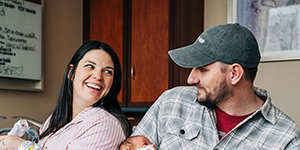Kelsey Hatcher,from Alabama in the US,has a rare medical condition called uterine didelphys that leads to a divided reproductive system.

Kelsey holds Roxi while her husband,Caleb,holds Rebel.Andrea Mabry/University of Alabama at Birmingham
After three previous children,Hatcher found out earlier this year that she was carrying two babies,one in each womb,in a medical rarity.
Both babies,Roxi and Rebel,were delivered healthy earlier this week during a 20-hour labour,with Roxi born vaginally at 7.45pm on December 19,before a C-section brought Rebel into the world less than 12 hours later on December 20.
Uterine didelphys occurs in about 0.3 per cent of women and is a birth defect that occurs when a female foetus is in the womb.
The reproductive system fails to merge properly into one large space in utero and insead a woman is left with two uteruses.
Some women with the condition have only one functioning womb,but Hatcher has two fully functioning uteruses,each with one fallopian tube and ovary,and two separate cervixes.
She had previously given birth naturally to children from both of her wombs,and initial scans earlier this year for her fourth pregnancy revealed that she was pregnant with twins,with one in each womb.
Her doctors,Shweta Patel and Richard Davis,from University of Alabama at Birmingham (UAB),looked at a handful of similar case studies dating back decades to inform their care of the unusual pregnancy.
The anatomical quirk meant that each child had a womb,sac,placenta and umbilical cord,and there was more space for each child compared with two foetuses in a sole uterus. Both children weighed more than three kilograms at birth,which had to be induced at 39 weeks.
Each uterus had its own labour and contractions and after giving birth naturally,Hatcher was then in an unusual position of being in both labour and postpartum recovery simultaneously.
“She was having contractions with Baby B while breastfeeding Baby A,” Dr Patel said.
Neither Patel or Davis,who have more than 60 years of combined experience,had delivered such a pregnancy before but their experience of having cared for Hatcher during a previous birth,pooled expertise of colleagues and analysis of case studies ensured a healthy,successful birth.
There is some debate about whether the girls are technically twins as the definition states being from the same uterus,but the doctors believe this to be a matter of pedantry and semantics.
“She is a lady that is pregnant with two babies in her tummy,and to us that is twins,but each one has its own apartment,so to speak,” said Davis.
“But they will be fraternal twins. In other words,if she had a regular uterus she would probably have two in the same uterus.”
The exact rarity of the birth is unknown,with only a handful or recorded cases since it was first written about in 1927.
Patel said that because of the rarity of such an event there is no global authority on the topic.
There have been recent births in England,Australia and Bangladesh,as well as an instance of triplets being born from a split uterus. One Japanese woman delivered twins more than two months apart in 2003.
Experts say the odds of having fraternal twins is about one in 100 births.
The odds are longer than that,however,for having two full-term,healthy twin daughters that each developed in their own uterus,with Davis believing it is at least a one-in-a-million event.
“Never in our wildest dreams could we have planned a pregnancy and birth like this,but bringing our two healthy baby girls into this world safely was always the goal,and UAB helped us accomplish that,” Hatcher said.
“It seems appropriate that they had two birthdays,though. They both had their own ‘houses’,and now both have their own unique birth stories.”
The Telegraph,London